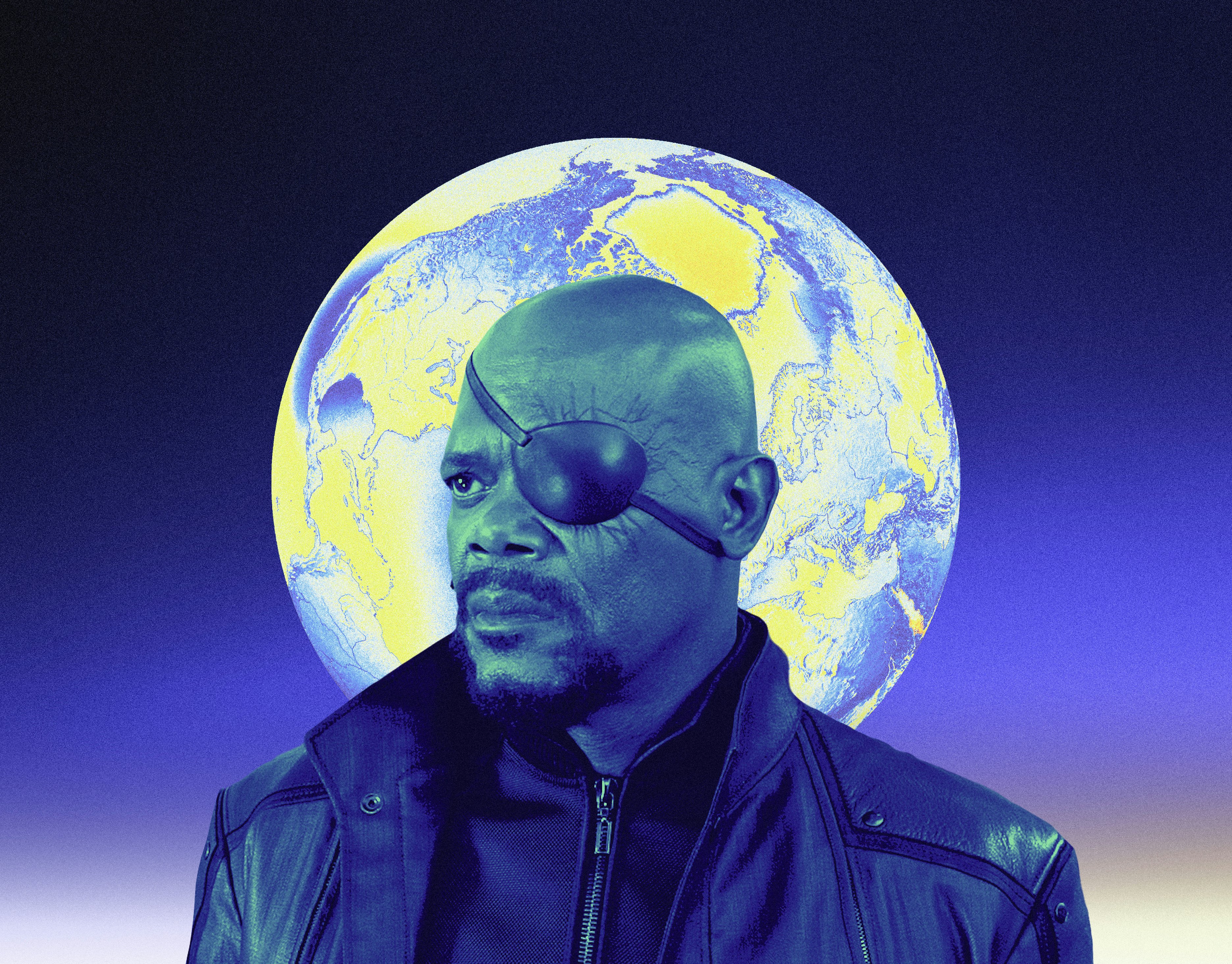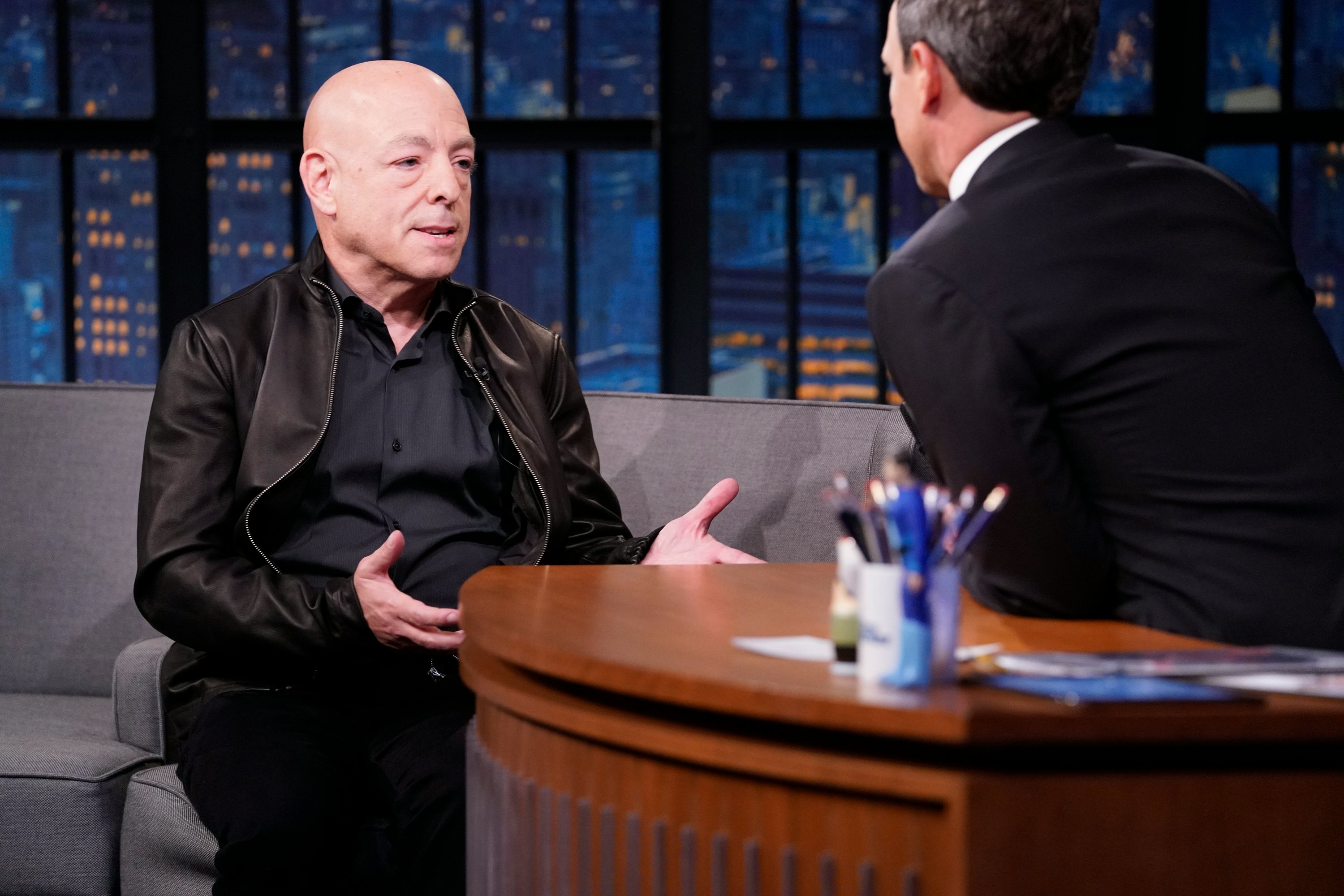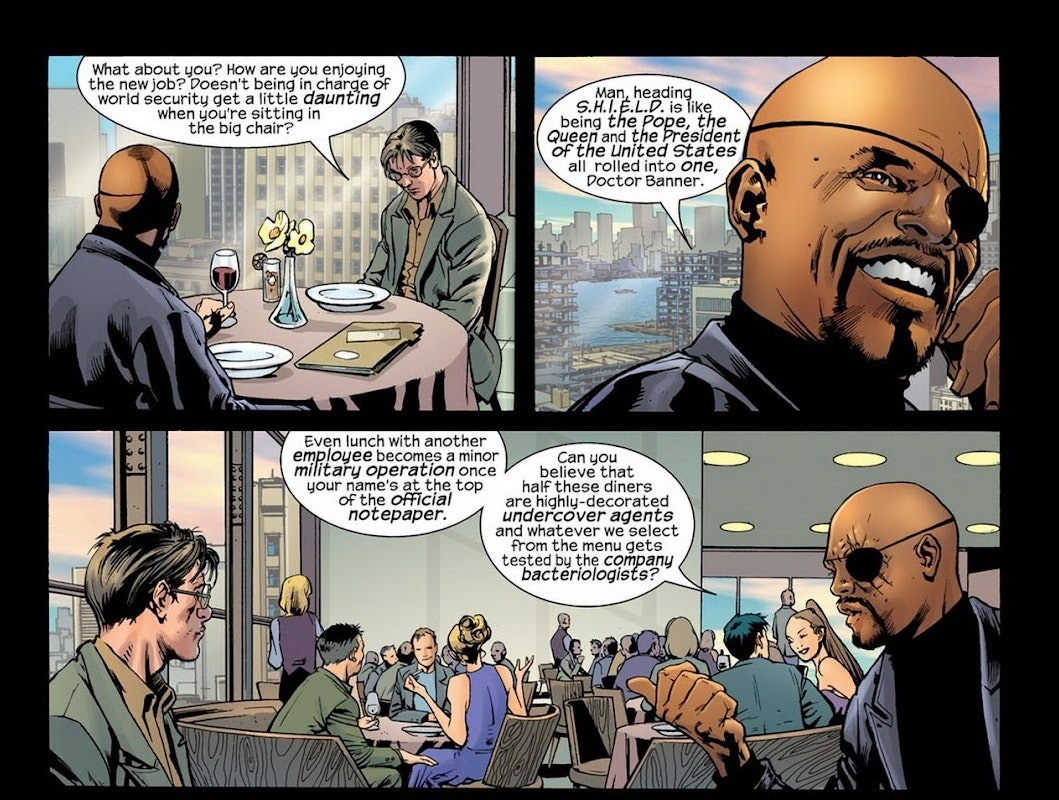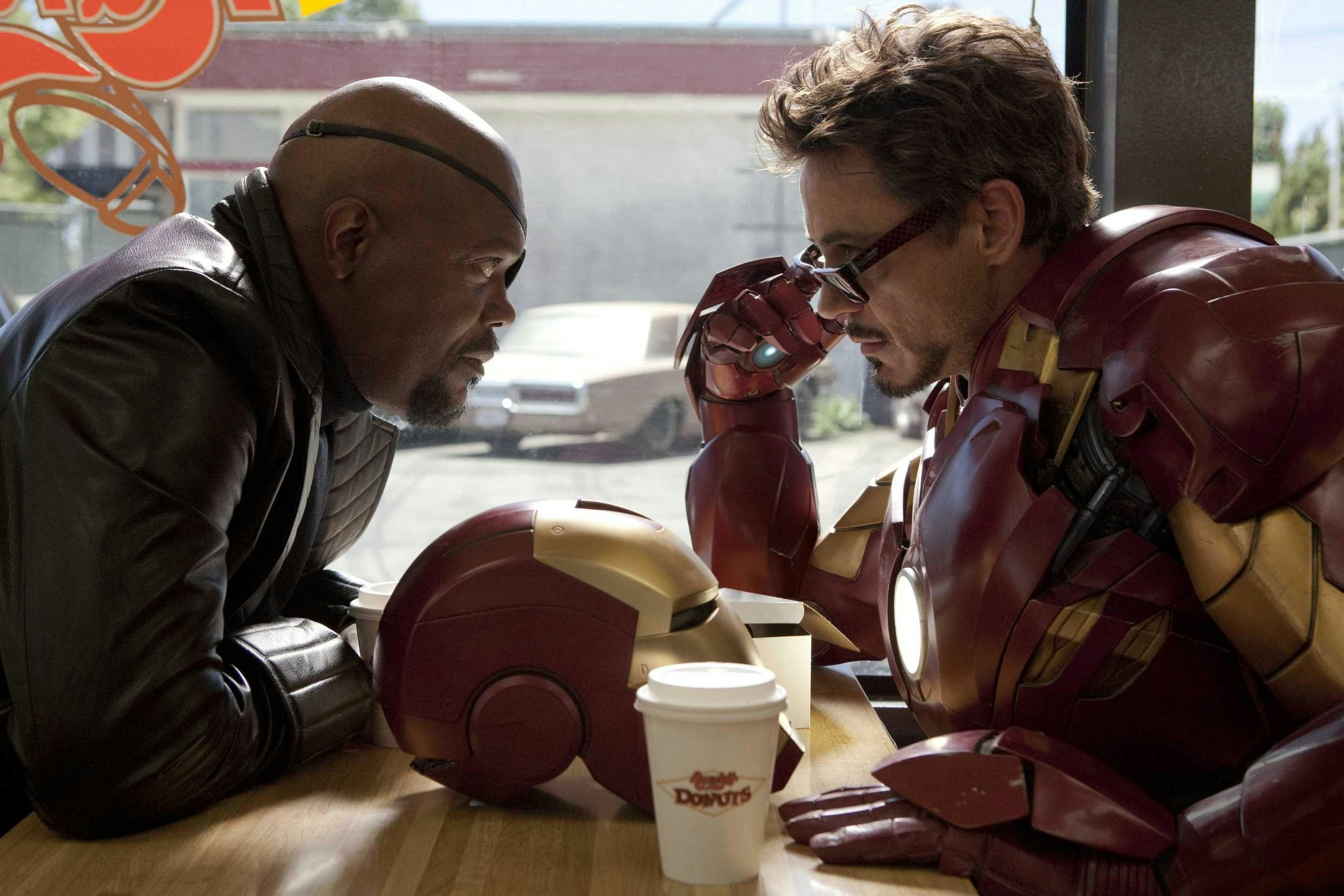
Two words were all it took to launch the Marvel Cinematic Universe: “Avenger Initiative.”
Uttered by an ultra-cool Samuel L. Jackson as Nick Fury at the end of Iron Man, the ripple effect has lasted 15 years and counting. But the only reason Jackson had anything to say in the first place was because comic book legend Brian Michael Bendis wrote the words.
“My memory is: Write everything you can think of,” Bendis tells Inverse. “As delightful as that sounds, I stayed up all night. This was like a writer’s puzzle. I wrote a couple pages down. I wrote every serious thing you can think of and every dumb thing you can think of.” (The results ranged from that iconic Avengers line to an X-Men reference to a Snakes on a Plane joke, but we’re getting ahead of ourselves.)
On May 2, 2008, Iron Man hit theaters with a sonic boom. Directed by Jon Favreau, produced by Avi Arad and Kevin Feige, and starring a rehabilitated Robert Downey Jr. as Tony Stark, Iron Man’s wasn’t just a $585 million blockbuster-level success for upstart Marvel Studios. It was the launch of a novel experiment. Since Iron Man, the Marvel Cinematic Universe (or, as we all know it, the MCU) has grown to encompass more than 30 theatrical films, almost a dozen TV shows, billions of dollars in revenue, and a film-changing cultural dominance. But it all arguably started with those words Bendis penned.
The majority of the movie deals with Iron Man’s origin story, but after the credits roll, the movie returns to Tony’s luxe mansion at dusk. That’s where an unadvertised Sam Jackson steps out of the shadows as Nick Fury, a secret agent and fixture in Marvel’s comics universe. “You think you’re the only superhero in the world?” Fury asks him. “Mr. Stark, you’ve only become part of a bigger universe. You just don’t know it yet.” After Fury introduces himself as the “director of S.H.I.E.L.D.,” he invites Tony Stark for a chit-chat about “the Avenger Initiative” before the movie actually ends and cuts to black.
Clocking in at 35 seconds, this moment set up 2012’s The Avengers (Marvel’s first billion-dollar movie) and hardwired audiences to stay in their seats until the lights came up. But to Bendis, the magic of Marvel’s first post-credits scene is its efficiency.

“Post-credits scenes can be a delightful exercise,” Bendis says. “It’s like a good cliffhanger. You leave the movie thinking about the story told, and you’re creating what you think might be the next story. The takeaway is that the credits [show] a world of imagination beyond what they were just shown. Isn’t that what this is all supposed to be about?”
To mark the 15th anniversary of Iron Man and the birth of the Marvel Cinematic Universe, Inverse caught up with Brian Michael Bendis to revisit the circumstances of his role in scripting the now-unforgettable moment that truly forged the MCU — and what it means for him after a long, prolific career in the comic book industry.
Betting on the House of Ideas

In 2000, Brian Michael Bendis emerged from the independent comic book scene and joined Marvel Comics to write a modern reboot of Spider-Man, titled Ultimate Spider-Man. Its success boosted Bendis’ profile, leading to major crossovers like House of M, Secret Invasion, and Age of Ultron, along with the chance to co-create Miles Morales.
Separately, Marvel was shaking off Chapter 11 bankruptcy and enjoying a resurgence thanks to a slew of superhero movies made at studios like Fox and Sony. In 2005, Marvel took out a risky loan of more than $525 million from Merrill Lynch to fund its own efforts to produce movies based on its comics. Iron Man became the first film in Marvel’s grand plans for a comic-book-style shared universe on the big screen.
So much rested on Iron Man’s titanium shoulders. If the movie was anything but a hit, Marvel would not only lose money, but its entire identity — including its characters and library of stories — would belong to the banks. To ensure that at least Marvel’s fans showed up, soon-to-be president of production Kevin Feige and others at Marvel Studios assembled a committee of comic book talent to act in a hybrid role that was equal parts story consultants and test audience. Among them was Brian Michael Bendis.
“Welcome to the Avengers!”
“During production of Iron Man, Kevin and the gang put together a group of people that were in the Marvel office and knew a damn thing about Iron Man,” Bendis recalls. “Marvel had leveraged their library for a bank loan to make Iron Man. If it worked, great. If it didn’t, the bank owned Marvel. So it was all hands on deck.” The role included reading scripts and providing notes, while also seeing early cuts of the movie.
With so much on the line and secrecy so important, traditional test screenings weren’t an option. So it was up to Bendis and the rest of the group to be as honest as possible.
“It’s unusual,” he says. “I often point out that Marvel’s magic sauce is that they take in all the information. They had a brain trust, and they trusted it for a very long time.”
For Bendis, working on an expensive movie — budgeted at $140 million — was a complete 180 from where Marvel had been just years before.
“I was hired when they were in bankruptcy just a few years before,” he says. “They were selling their own furniture for cash. Now here we are, a few years later on the set of a big-budget Iron Man movie they were making themselves. It was all very exciting and different and new. It was like the size of a studio film but the energy of an independent.”
The “committee” Marvel assembled consisted of many of its comic editors, while Bendis and fellow scribe Mark Millar (of titles like Old Man Logan and Civil War) were the writers present. “That was the beginning of the Marvel Creative Committee that held together for the first three phases of the MCU, which they made official after Iron Man,” he says. “But at the time, it was anybody who knew anything. ‘Look at this; what do you think?’ I’m a film nerd and I have all these philosophies of my heroes in my head. Just trying to apply them to what was in front of us was exciting.”
“He’s just showing up and we’re gonna wing it”

During principal photography on Iron Man, Bendis was at Long Beach Comic Con when his phone rang late on Friday night. It was Kevin Feige on the line.
“I got a call from Kevin, who said, ‘Samuel L. Jackson is showing up tomorrow to do a favor. He’s just showing up and we’re gonna wing it,’” Bendis recalls.
This was before Marvel had developed any concrete plans to create a cinematic universe. But Feige asked, “Do you have time to write anything?” And Bendis replied, “Yeah! Shit!”
The connections between Samuel L. Jackson and Nick Fury go further back than 2008’s Iron Man. In 2001, Bendis authored Ultimate Marvel Team-Up, a comic book series that features the first appearance of a reimagined Nick Fury. Originally a shadowy agent created by Stan Lee and Jack Kirby in 1963, Fury was made popular in the ’70s by Jim Steranko and played by David Hasselhoff in a made-for-TV movie. He was also white.
“I’m here to shut you down. You’re done. There’s no Iron Man.”
Working with artist Mike Allred, Bendis reimagined Nick Fury as a Black man. In the 2002 comic book The Ultimates (by Mark Millar and Bryan Hitch), Fury appears with a pronounced resemblance to Samuel L. Jackson. It was by design. In a 2015 interview with Business Insider, Millar said they intentionally modeled Nick Fury after the Pulp Fiction star.
“Nick Fury sounded like one of those great 1970s Blaxploitation names, and so the whole thing coalesced for me into a very specific character, an update of the cool American super-spy Jim Steranko had done in the ’70s,” Millar said. “Sam is famously the coolest man alive and both myself and artist Bryan Hitch just liberally used him without asking any kind of permission. … What we didn’t know was that Sam was an avid comic fan and knew all about it.”

When Jackson’s agent contacted Marvel about the likeness, the publisher promised the actor could play Nick Fury in an eventual movie. That opportunity came with Iron Man. (The Merrill Lynch agreement included mention of a Nick Fury film.) In the 2021 book The Story of Marvel Studios: The Making of the Marvel Cinematic Universe, associate producer Jeremy Latcham said there wasn’t a deal in place when Jackson was contacted for Iron Man.
“It was just this weird idea that maybe people give a shit if we stick it on the end,” Latcham said.
Years later, when Millar apologized to Jackson on the set of Kingsman: The Secret Service for stealing his likeness, Jackson quipped, “Fuck no, man. Thanks for the nine-picture deal.”
While Feige personally asked Bendis to write the Iron Man scene, there wasn’t exactly a script. Instead, he simply jotted down lines for Jackson to say as Nick Fury. Marvel gave no instructions about what the scene should involve or tease about future movies. All Bendis knew was that he had to come up with words for a prolific Oscar-nominated actor. According to the writer, some of those included:
- “Put down your armor.”
- “Welcome to the Avengers!”
- “I’m here to shut you down. You’re done. There’s no Iron Man.”
- “Let’s talk about the Avengers Initiative.”
- “Get that motherfucking armor off your motherfucking…” (“Snakes on a Plane had just come out,” Bendis says, “so it wasn’t tacky; it was still in the lane of a solid joke.)
“It wasn’t normal, where you have an assignment and them going, ‘We need Nick Fury to get him to the Avengers,’” Bendis recalls. “That is not what they said. They said, ‘Nick Fury is showing up. What should he say?’”
Bendis says he “wrote every version of anything it could possibly be” and let Marvel decide. The rest is MCU history.
“When I saw they went with Avengers — the promise of more — it was obviously the right choice,” he says. “It’s a big fingers-crossed [moment] because nothing was set. A lot of good things have to happen for an Avengers movie to happen. As soon as the movie opened, it was obvious the goal was in reach.”
“Get them to come back”

Today, audiences are familiar with the concept of the post-credits scene, largely because of Marvel’s influence and the buzz Iron Man generated. But Marvel didn’t invent the concept. Classic comedies like The Silencers, Airplane!, and Ferris Bueller’s Day Off famously included extra scenes, which most audiences only found out later on home video. Even superhero movies before 2008 like Daredevil and X-Men: The Last Stand had them.
What made Iron Man different was that it had a specific function: hint at what’s next and foster more speculation than expectation.
“Once they became a thing, it [felt] like a reflection of a Stan Lee storytelling device,” Bendis says, “which is ‘We’re never letting you go.’ Stan always talked about how every comic is someone’s first and it’s the job [of a writer] to never make it the last. I took that as my job, too. Get them to come back. We’re always playing with the strongest cliffhangers and the strongest pullback, and the after-credits scenes absolutely do that. We’re never letting you go.”
“Get that motherfucking armor off your motherfucking...”
The secrecy around the scene was also unusual. Before May 2, 2008, no one could say with certainty that Marvel Studios would rake in billions as a pop-culture behemoth. Still, Marvel knew ahead of time the value of keeping its juiciest secrets close to the chest.
“The hardest part of my time was sitting on huge nerd secrets,” Bendis says. “Big ones. I knew them years ahead of time. I’d be at dinners where my friends were fan-ing out about something I knew the answer to, and they were trying to guess what’s going to happen. Those secrets were a burden. But I loved it.”
Bendis boasts many accomplishments in his long professional career in comics. His creator-owned imprint Jinxworld is now at Dark Horse, and its titles like Powers have also become TV shows. But getting to play a role in shaping Marvel’s big screen universe is a more personal achievement.
“When I got the call, it was nice to hear that I had earned [it]. ‘We can trust Brian with this.’ That carried with me all the way through to the end of my Marvel run.”







